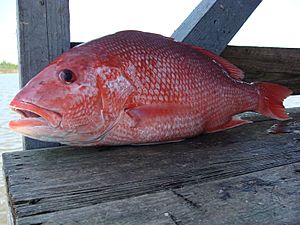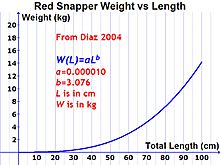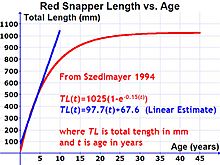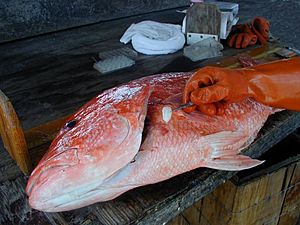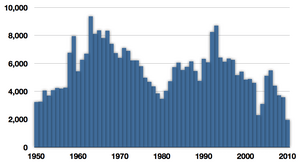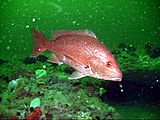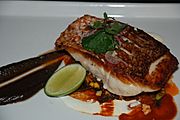Northern red snapper facts for kids
Quick facts for kids Northern red snapper |
|
|---|---|
 |
|
| Conservation status | |
| Scientific classification | |
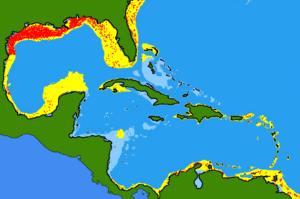 |
|
| Synonyms | |
|
The northern red snapper (Lutjanus campechanus) is a type of snapper fish. It lives in the western Atlantic Ocean, the Caribbean Sea, and the Gulf of Mexico. You can usually find them around reefs. This fish is very important for fishing businesses and is also popular for people who fish for fun.
Contents
What Does a Northern Red Snapper Look Like?
The northern red snapper looks a lot like other snapper fish. They all have a sloped head, medium-to-large scales, and a spiny fin on their back (called a dorsal fin). Their bodies are also flattened from side to side.
Northern red snappers have short, sharp, needle-like teeth. However, they don't have the big, pointy canine teeth that some other snappers have. These fish are quite large and have a reddish color.
They become adults when they are about 39 cm (15 in) long. Most adult northern red snappers are about 60 cm (24 in) long, but some can grow up to 100 cm (39 in). The heaviest northern red snapper ever recorded weighed over 50 pounds (22.79 kg (50.2 lb)). Some can even live for more than 100 years!
Their color is a light red, with a darker red on their back. Young northern red snappers (shorter than 30–35 cm) might have a dark spot on their sides. This spot fades away as they get older.
Where Do Northern Red Snappers Live?
You can find northern red snappers in the Gulf of Mexico, the Caribbean Sea, and along the southeastern Atlantic coast of the United States. Sometimes, they are seen as far north as Massachusetts. In Latin American Spanish, people call them mero, huachinango, pargo, or chillo.
These fish usually live in waters from 9–60 m (30–200 ft) deep. But sometimes, they can be found as deep as 90 m (300 ft). They like to stay close to the bottom of the ocean. Their favorite places are rocky areas, ledges, ridges, and man-made reefs. This includes old oil rigs and shipwrecks.
Like most snappers, northern red snappers like to be with other fish. They form large groups, called schools, around wrecks and reefs. These schools usually have fish that are all about the same size.
As northern red snappers grow, they move to different types of homes. This is because they need more places to hide and their food changes. When they are very young, they spread out over open areas on the ocean floor. Then, they move to low-lying areas, like oyster beds. As they get older, they move to bigger reefs. The largest red snappers can live in open areas or on reefs.
Reproduction and Life Cycle
As northern red snappers get longer, they also get heavier. Scientists can study their growth by looking at their length and weight.
Northern red snappers move to different habitats as they grow. When they are just born, they live in open areas on the ocean floor. Before they are one year old, they move to places with low hiding spots, like oyster beds. As they get bigger, they move to places with more hiding spots. Around age two, they look for large reefs where there aren't too many bigger snappers.
At oil platforms, smaller snappers stay higher up in the water. The older, larger snappers live in the deeper parts of the platforms and reefs. These big fish often don't let smaller fish share their space. Even though they like certain spots, many northern red snappers don't move very far. Most stay close to where they were first found.
A northern red snapper can start having babies when it is two to five years old. An adult snapper can live for more than 50 years. Some studies have shown that red snappers off the coast of Texas grow up faster and are ready to reproduce at a smaller size than those off Louisiana and Alabama.
Fishing for Northern Red Snappers
Northern red snappers are a very popular fish to eat. They are caught by both commercial fishermen (who sell them) and recreational fishermen (who fish for fun). In Vietnam, red snapper is used in a sour soup called canh chua. It's the most common snapper caught in the USA.
These fish will eat almost anything, but they especially like small fish and crabs and shrimp. People can catch them using live bait, cut bait, or even fake lures. They are often caught weighing up to 4.5 kg (10 lb) and being 510 mm (20 in) long. But some fish over 18 kg (40 lb) have been caught!
Fishing for northern red snapper has been popular for a long time. There are rules about how many fish can be caught to make sure there are enough for the future. The first rule about how small a fish could be was made in 1984. This was because reports showed that fewer and fewer red snappers were being caught.
When a northern red snapper bites a fishing line, they often nibble gently. So, fishermen need to be careful and feel for the bite. Since older red snappers like to hide around structures, fishermen often drop their lines to the bottom near reefs, wrecks, and oil rigs. They use strong fishing lines. Fishermen often use several hooks with different baits, like squid, small whole fish, or strips of fish like amberjack.
Since 1990, the total number of northern red snappers that can be caught each year has been split. Recreational fishermen can catch 49% and commercial fishermen can catch 51%. Commercial fishermen often use electric reels with many hooks. Fishing for red snapper used to be a very big business in the Gulf of Mexico. However, new rules and limits have made it harder for commercial fishermen to catch them. Scientists are also worried about young red snappers that are accidentally caught by shrimp boats. This is called "bycatch."
Sometimes, fish sold as "red snapper" in stores or restaurants are not actually northern red snappers. They might be other types of fish that look similar but are cheaper. This happens more often in big restaurant chains. In some countries, like India, other types of snapper are sold as "red snapper" because the real northern red snapper doesn't live there.
Helping Northern Red Snappers with Artificial Reefs
Young northern red snappers have been released into artificial reefs off the coast of Sarasota, Florida. This helps scientists study if fish grown in fish farms can help increase the number of wild red snappers in the Gulf of Mexico. Artificial reefs off the coast of Alabama are a favorite home for red snappers that are two years old and older. Studies have shown that a large percentage of young red snappers in that area live around offshore oil platforms.
Other Fish Sometimes Called Red Snapper
- Sebastes, also known as rockfish, are sometimes called red snapper or Pacific red snapper.
- Several types of bigeye fish (Priacanthidae)
- Lane snapper
- Blackfin snapper
- Video: Red Snapper hunting (Red Sea, Egypt)
See also
 In Spanish: Huauchinango Pez para niños
In Spanish: Huauchinango Pez para niños



